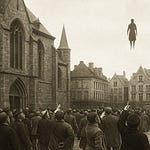Somewhere beyond the reach of the modern world, tucked in the stillness of the Scottish countryside, there is a chapel made not of stone, but of song.
Rosslyn Chapel has always attracted truth seekers. It appears in thrillers and conspiracy theories, wrapped in stories about the Knights Templar and ancient bloodlines. It is a place people point to when they feel there is something beneath the surface of things. Something hidden. Something holy. But the truth is stranger than the legends.
This chapel does not just hold music. It is music.
Inside, along the arches, are 213 stone cubes, each carved with strange dots and lines. For centuries, no one knew what they meant. Most called them decoration, assuming they were the work of a whimsical stonemason. But in 2007, a father and son named Thomas and Stuart Mitchell noticed something others had missed. These were not random symbols. They were sound.
The cubes, it turned out, were cymatic patterns. Cymatic patterns are shapes created by sound waves moving through matter. If you take a plate of metal, sprinkle it with sand, and run a frequency through it, the sand forms a shape. The shape depends on the frequency. This is cymatics. The Mitchells matched each cube in the chapel to a specific tone, then played them in sequence.
The result was a slow, chant-like hymn. The Rosslyn Motet.
When played inside the chapel, something strange happens. The building seems to respond. The melody fills the space, folds in on itself, echoes back in patterns that feel deliberate. It is as if the structure recognizes the song. As if the room is completing it.
Rosslyn is not the only place where this happens.
Medieval builders believed that sound and form were not separate. They believed that music and architecture spoke the same language. They used musical ratios to guide their design. The octave, a 2:1 ratio. The fifth, a 3:2 ratio. These were not just mathematical tricks. They were sacred. They were ways of aligning the built world with the divine.
Cathedrals like Chartres and Notre Dame were constructed according to these principles. The structures themselves became instruments. The space was designed to resonate. To lift the spirit. To bring the unseen into form.
Rosslyn follows the same path. The proportions of the building echo musical intervals. The stone itself carries the song. And when that song is played, the room becomes a vessel. Not just for sound, but for meaning. Not just for the ears, but for the soul.
Architecture is often described as frozen music. In Rosslyn, the music has begun to thaw. You can hear it. You can feel it. Something in the geometry, in the ratios, in the silence between sounds, points beyond itself. The builders were not just making a place where people would come to worship. They were building the worship itself.
The modern world no longer builds this way. Our buildings speak of function, economics, and practicality. The old builders spoke of beauty, transcendence, and of order beyond what the eye could see.
Rosslyn stands against this forgetting. It is a relic, yes, but also a revelation. It shows what we used to know. That sound is not noise. That space can pray. That the sacred sometimes hides in stone, in silence, in subtle harmonies we have forgotten how to hear.
If you’re reading this, thank you. I put a great deal of time and care into each piece, and it means a lot to share this work with you.
If you haven’t yet, I encourage you to subscribe to my YouTube channel, where I post all of my video essays exploring the hidden, the sacred, ancient symbols, and spiritual mysteries. Your support helps me continue creating this kind of work.
I also created a Christian meditation app called Hope Mindfulness & Prayer, which is linked below. It’s designed to help you build a daily habit of stillness, scripture, and reflection. In a world filled with noise, I believe making space for quiet is more important than ever.
My YouTube: https://www.youtube.com/@tayjmcm
My Meditation App:










